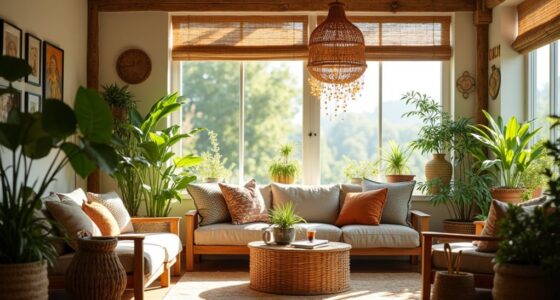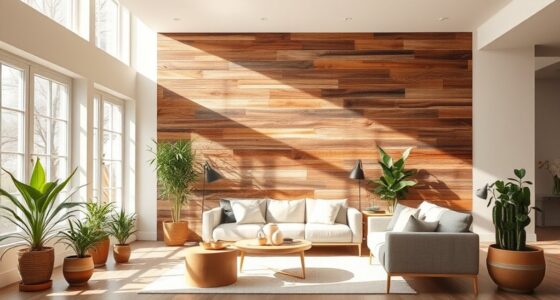Choosing sustainable flooring like bamboo and reclaimed wood is a smart way to enhance your boho home’s style and eco-friendliness. Bamboo is a fast-growing, renewable resource, while reclaimed wood offers unique character and reduces waste. Proper installation and finishes guarantee durability and health benefits. With careful selection and preparation, these materials can create a beautiful, sustainable space. Keep exploring to discover tips for installing and maintaining these eco-friendly options effectively.
Key Takeaways
- Select eco-friendly materials like bamboo and reclaimed wood to enhance sustainability and natural aesthetic in boho homes.
- Ensure proper installation, including stable subfloors and acclimation, to prevent warping and ensure longevity.
- Use low-VOC finishes and adhesives to maintain healthy indoor air quality and eco-conscious standards.
- Reclaimed wood adds character and reduces waste, aligning with the boho style and environmental values.
- Proper maintenance and care maximize durability and preserve the natural beauty of sustainable flooring over time.

When selecting flooring for your home, choosing sustainable options not only benefits the environment but also enhances your space’s health and durability. Eco-friendly materials like bamboo and reclaimed wood are popular choices for boho homes because they bring natural beauty and a sense of history into your space. Bamboo grows incredibly fast, making it a highly renewable resource, while reclaimed wood repurposes old timber, reducing waste and the need for new harvesting. These materials help you create a stylish, eco-conscious environment without sacrificing quality or aesthetics.
Choosing sustainable flooring like bamboo and reclaimed wood boosts your home’s style, health, and eco-friendliness.
However, before you decide, you should consider installation considerations. Bamboo flooring, for example, often requires a stable, level subfloor to prevent warping or gaps over time. It can be installed as floating floors, glue-down, or nail-down, and each method has its own requirements. Reclaimed wood, on the other hand, may present unique challenges due to its varied dimensions and potential for existing damage. It’s important to inspect reclaimed planks carefully, ensuring they’re properly dried and treated to prevent future issues like warping or pests. Proper preparation of the subfloor is essential for both options to guarantee a secure, long-lasting installation.
When planning your installation, keep in mind that eco-friendly materials sometimes need specific adhesives or finishes to meet sustainability standards. Opt for low-VOC or natural sealants that won’t off-gas harmful chemicals into your living space. This consideration is vital for maintaining indoor air quality and supporting your home’s health. Additionally, think about the overall layout and expansion gaps needed for natural materials, especially with reclaimed wood, which may expand or contract with humidity changes. Proper acclimation of the flooring in your home before installation can minimize these issues. Understanding material behavior is crucial for a successful installation and long-term performance.
Choosing sustainable flooring like bamboo or reclaimed wood aligns with your boho aesthetic and commitment to eco-conscious living. These materials, when installed with careful attention to installation considerations, can stand the test of time, adding warmth and character to your space. By selecting eco-friendly options and preparing properly for installation, you guarantee your flooring not only looks beautiful but also supports a healthier environment, both inside and out. Remember, the right installation techniques make all the difference in maximizing the lifespan and beauty of your sustainable flooring, turning your home into a true sanctuary of style and sustainability.
Frequently Asked Questions
How Does Bamboo Flooring Compare to Traditional Hardwood in Durability?
Bamboo flooring generally offers a strong durability comparison to traditional hardwood, making it a resilient choice for your boho home. Its material resilience means it can withstand daily wear and tear, especially if you choose high-quality, dense bamboo. While hardwood can be prone to scratches and dents, bamboo’s tight grain enhances its durability, ensuring your floors stay beautiful longer. Overall, bamboo provides a sustainable, durable alternative to traditional hardwood flooring.
Are Reclaimed Wood Floors Prone to Pests or Mold Issues?
Reclaimed wood floors are generally resistant to pests if properly treated, but they can be prone to mold if moisture gets trapped or if there’s poor ventilation. To guarantee pest resistance and mold prevention, you should have the wood professionally inspected, treated, and sealed. Regular cleaning and controlling indoor humidity also help prevent mold growth, keeping your reclaimed wood flooring both beautiful and safe for your boho home.
What Is the Cost Difference Between Bamboo and Reclaimed Wood Flooring?
You’ll find that bamboo flooring typically costs less than reclaimed wood, making it a budget-friendly choice. The price comparison varies depending on factors like quality, installation, and source. Reclaimed wood can be pricier due to its rarity and the work involved in reclaiming and preparing it. Price factors such as sourcing, finish, and craftsmanship influence the final cost, so weigh these when choosing your sustainable flooring option.
How Eco-Friendly Are the Manufacturing Processes for Bamboo Flooring?
You’ll find that bamboo flooring manufacturing is quite eco-friendly, thanks to sustainable harvesting practices that renew bamboo quickly. The production process often involves eco conscious manufacturing methods, reducing chemical use and waste. This makes bamboo a greener choice compared to other flooring options. By choosing bamboo, you support sustainability, minimize environmental impact, and enjoy beautiful, eco-friendly flooring for your boho home.
Can Reclaimed Wood Flooring Be Safely Used in Humid Climates?
You might think reclaimed wood flooring isn’t suitable for humid climates, but with proper treatment, it can be safe and durable. Reclaimed wood offers good moisture resistance when sealed correctly, preventing warping and mold. However, be aware of installation challenges, like expanding or contracting due to humidity fluctuations. Regular maintenance and choosing the right sealant help make sure your reclaimed wood stays beautiful and stable in humid environments.
Conclusion
Choosing sustainable flooring like bamboo or reclaimed wood isn’t just about style—it’s about making a positive impact. Imagine your home as a garden; every eco-friendly choice you make helps it flourish. I once swapped my traditional floors for reclaimed wood, and it felt like giving my space a second chance at life. Just like a garden thrives with care, your home can flourish sustainably, proving that small choices can create big, beautiful change.








